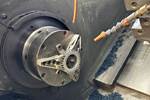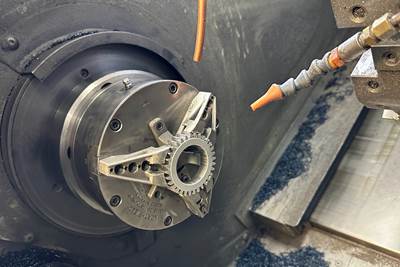Metal additive manufacturing (AM) is sometimes thought to be in competition with machining, but increasingly, additive parts are bringing benefits to the subtractive process. Turning equipment supplier Index recently highlighted two such parts, both end-use components for its bar feeders that were redesigned to take advantage of AM’s part consolidation benefits. The company is seeing production and supply chain advantages as well as cost savings in choosing additive for these components, thanks in part to the use of a low-cost 3D printing platform for laser powder bed fusion (LPBF) that makes this technology more accessible and affordable.

In a recent case study, Index redesigned the slider trolley (lower) and clamping piece for the bar feeder in its multispindle turning centers to be made through additive manufacturing. The new designs use less material and require fewer steps to produce; read on to learn how. Source: One Click Metal
Low-Cost Laser Powder Bed Fusion

Laser powder bed fusion (LPBF) applies energy from a laser to a bed of metal powder to melt together just the material that is needed to form the cross section of each layer of the part. Source: One Click Metal
The case study components came about in part because of Index’s relationship with One Click Metal, a company offering a compact, entry-level metal 3D printing platform. Index is a majority investor in One Click Metal, and also a user of this platform.
One Click Metal originally spun out from laser technology Trumpf (which remains a strategic partner), and has developed a laser powder bed fusion 3D printer and accompanying unpacking and sieving station intended for ease of use and affordability. LPBF uses a laser (in this case, a 200-W fiber laser with focus diameter of 70 micron) to melt metal powders layer by layer to build solid metal parts.
The BoldSeries platform consists of the 3D printer (right) where parts are built, and the unpacking/sieving station (left) where metal powder is reclaimed, sieved and mixed as necessary.
One barrier to entry with laser powder bed fusion is powder management. Metal powder must be carefully handled to maintain its quality, and also to protect the health and safety of workers and facilities. Operators must wear appropriate PPE to load material, remove and depowder parts from the build chamber, and clean the machine of unsintered material after 3D printing.
One Click Metal’s BoldSeries platform has been designed to minimize operator contact with the powder metal, using a cartridge system to load and manage material. The build chamber is minimally contaminated during printing, making clean up easier, and the entire build volume can be moved from 3D printer to material handling station for contained depowdering and recapture of unsintered material.
According to One Click Metal, the platform was developed to be accessible and easy to use for labs, universities and small to medium manufacturers, even those with no prior experience using metal 3D printing. The two machines occupy a small footprint and enable a user to get started with laser powder bed fusion for about $200,000.
In addition to investing in One Click Metal, Index has also been using this LPBF platform internally. Recently the company leveraged the 3D printer to redesign two components of a bar feeder for its multispindle turning centers: the slider trolley and the clamping piece needed to feed each metal bar into the machining process. Index requires 520 of each of these components each year.
Slider Trolley: 2 Parts to 1

The original slider trolley (top) features two parts welded together, which had a tendency to fail at the weld seam. The first design for AM recreated this geometry as one piece to avoid this point of failure.
The slider trolley attaches to the clamping piece with screws and serves as its “arm,” transferring the latter’s axial movement to the bar using a spring-loaded ram. Currently, the slider trolley part is manufactured by welding together a turned component and a cut sheet metal piece. The difficulty of the welding step increases the time and cost to produce the trolley, and the seam is a common point of failure which leads to scrapped parts. Produced conventionally, the slider trolley costs about 127 euro each (or 66,040 euro annually).
A team within Index decided to redesign the slider trolley so that it could be printed through laser powder bed fusion, using the MPrint BoldSeries 3D printer. The first design simply combined the flat and round components into a single part that could be 3D printed as one from 1.2709 (maraging steel M300). Getting the assembly down to just one part removed the welding step as well as the join as a potential point of failure.

The final slider trolley design was optimized for AM with trusses to remove material while maintaining strength. Avoiding excess material in the design reduces part weight, but also makes it faster and more affordable to 3D print. Source: One Click Metal
But the combined design used more material than necessary, which would mean longer print times and higher costs in production. So, the collaborators focused next on removing excess material while maintaining the slider trolley’s functionally. The final design makes use of open triangles to provide strength while removing weight; the part’s volume and build time were both reduced by 15% in this version.
By orienting the parts vertically on the 150 × 150-mm build plate, Index was able to fit 42 pieces into a single 3D print cycle, which takes 50.5 hours to complete. Consolidating the assembly to avoid the welding steps and reducing material usage resulted in a final cost of about 29 euro per part, a savings of about 77%.

42 slider trolleys can be 3D printed in one build. Source: One Click Metal
Clamping Piece: 5 Steps to 1
The original clamping piece (top) is constructed of two stainless steel plates and an aluminum body. Index redesigned the component first as a single piece, and then further optimized it to reduce material usage.
The clamping piece sits on a V-belt and conveys barstock to the machining area of the turning center, assisted by the slider trolley. The component needs to fit on a C-rail and withstand moving back and forth with little wear. Additionally, the clamping piece requires threads for mounting.
The conventionally produced clamping piece is built from two stainless steel plates and an aluminum base body. The plates are pinned and screwed to the base before threads are cut into the aluminum, requiring significant assembly work. Individual parts are made by several different suppliers, complicating the supply chain and leading to a typical delivery time of 42 days for these components. Counting material procurement, there are five steps involved in the assembly of each clamping piece. Each of the assemblies costs 205 euro to produce, for an annual total of 106,600 euro.

In production, clamping pieces would most likely be printed 4 at a time on their sides to shorten the build time. Source: One Click Metal
Here again, Index redesigned the assembly to be producible as just one 3D printed part using maraging steel. A major advantage of the AM design is that the threads, which previously required tapping as a separate step, can now be 3D printed directly into the part and easily recut to finish the surfaces. Assembly is no longer required for the clamping piece, and the part can be built complete in just one location.
A sample build plate on display at IMTS 2024 showed how longer, thin parts similar to the clamping piece could be oriented vertically and stacked to pack more parts into a single print.
Four of the clamping pieces can be produced at once in the MPrint machine with a build time of 22.5 hours. (More can be 3D printed at once by standing them on end, but this orientation raises the number of layers required and therefore extends the build time.) Each clamping piece 3D printed in a four-part build this way costs just 97 euro, less than half of the previous component.
3D Printing Brings Speed and Flexibility
Developing 3D printable versions of the slider trolley and clamping piece not only gives Index a more economical production route; it also makes future production more flexible. Laser powder bed fusion is a digital process, which makes it possible to easily support design changes in the future. Additionally, production can be undertaken on demand, reducing the need to store inventory of spare parts.
Beyond improving production for these two components, Index is realizing other benefits from using additive manufacturing in development. The company went from CAD creation to 40 ready-to-use clamping pieces and slider trollies in just 10 days. Compared to the standard lead time of about 6 weeks for the clamping pieces, changing the production process means significant gains in speed, which could also support more design iterations on future components without sacrificing time to market.
For bar feeder users, adoption of 3D printed components within these machines could translate into shorter wait times for equipment as well as better performance as a result of more reliable, longer-lived parts inside.
About the Author
Stephanie Hendrixson
Stephanie Hendrixson reports on 3D printing technology and applications as executive editor for Additive Manufacturing. She is also co-host of The Cool Parts Show, a video series that highlights unique, unusual and weird 3D printed parts, and co-host and creator of the AM Radio podcast. SUBSCRIBE HERE
Related Content
Pursuit of Parts Collector Spearheads New Enterprise
While searching for a small parts accumulator for Swiss-type lathes, this machine shop CEO not only found what he was looking for but also discovered how to become a distributor for the unique product.
Read MoreShop Sets its Sights on Precise Tool Alignment
A Wisconsin shop has found that visual tool alignment technology has improved tool life and surface finishes for its Swiss-type lathes while increasing throughput as well.
Read MoreLaser Technology "Turns" into a Turning Tool
This new technology uses a laser to act as a cutting tool to "turn" parts from solid barstock. This high-speed precision turning machine is especially useful for micromachining, enabling high accuracy for small, complex parts that are often delicate and difficult to machine when implementing conventional turning processes.
Read MoreShop Optimizes its Swiss-Turning Flexibility
Paramount Machine uses various Swiss-type lathes, some with a B axis, to produce parts more effectively than it did on conventional chucker lathes. Today, nearly every job under 1.5 inches in diameter runs across those machines even if the batch size is a mere 5 pieces.
Read MoreRead Next
Adding Additive Manufacturing to a CNC Machine Shop
With many types of metal and polymer 3D printing methods available, it might be difficult to identify the type that could be best implemented in your shop. Here is a rundown of these 3D printing processes along with how each can be used together effectively in a CNC machine shop.
Read MoreChuck Jaws Achieve 77% Weight Reduction Through 3D Printing
Alpha Precision Group (APG) has developed an innovative workholding design for faster spindle speeds through sinter-based additive manufacturing.
Read MoreA Tooling Workshop Worth a Visit
Marubeni Citizen-Cincom’s tooling and accessory workshop offers a chance to learn more about ancillary devices that can boost machining efficiency and capability.
Read More

.jpg;width=70;height=70;mode=crop)









.jpg)

.jpg;maxWidth=300;quality=90)




.jpg;maxWidth=300;quality=90)







